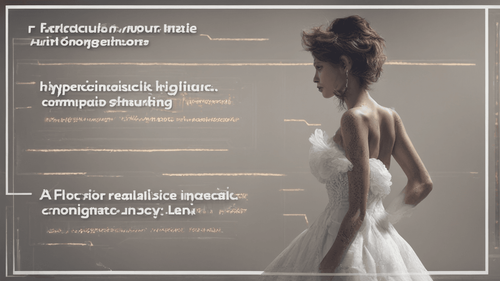
Introduction: Where Art and AI Converge
In the ever-evolving landscape of technology, artificial intelligence (AI) continues to push boundaries, reshaping industries and unlocking new avenues of creativity. One such groundbreaking application is the ability of AI to create pictures from text – a fusion of linguistic expression and visual artistry. This article delves into the captivating world of AI-generated artwork, exploring the mechanics, potential applications, and the intriguing intersection between language and imagery.
AI Create Picture from Text: Defining the Innovation
The Essence of AI-Generated Art
At the heart of the concept lies the intriguing idea of AI translating textual descriptions into visually stunning artwork. Imagine describing a serene landscape with lush greenery and a tranquil stream, and having AI transform those words into a breathtaking visual representation that captures the very essence of the scene. This blend of language and imagery showcases AI's prowess in understanding and interpreting human input.
The Picasso AI Approach
One notable player in this realm is Picasso AI – a trailblazing platform that harnesses the power of AI to craft images from textual prompts. Leveraging advanced deep learning algorithms and neural networks, Picasso AI brings to life an array of concepts and narratives, translating them into remarkable visual compositions that stimulate the imagination.
The Evolution of Artistic Expression
AI's foray into the world of art is not just about mechanical reproduction; it's about fostering creativity and augmenting human imagination. By enabling a seamless transition from text to image, AI offers artists, designers, and creators an additional layer of inspiration and exploration.
The Mechanics Behind the Magic: How AI Creates Pictures from Text
From Text to Pixels: A Step-by-Step Journey
The process of transforming text into images is a complex interplay of algorithms and data. Here's a simplified breakdown of how it works:
-
Textual Input: The journey begins with a textual description provided by the user – a scene, an emotion, or a concept.
-
Semantic Understanding: AI employs natural language processing (NLP) to comprehend the nuances and intricacies of the input. This step involves deciphering keywords, context, and emotional undertones.
-
Visual Synthesis: Drawing from a vast database of images and artistic styles, AI generates visuals that align with the textual cues. This involves understanding the relationship between various elements and arranging them harmoniously.
-
Artistic Rendering: The generated visual is refined using artistic techniques to imbue it with depth, texture, and emotional resonance.
-
User Interaction: The user is presented with the AI-created image, opening the door for feedback and iterative refinements.
The Role of Neural Networks
Central to this process are neural networks – AI's attempt to simulate the human brain's interconnected web of neurons. Deep neural networks, often referred to as deep learning, allow AI to learn patterns and relationships within data, thereby enhancing the quality of generated visuals over time.
The Synergy of Linguistics and Imagery
The true marvel lies in AI's ability to bridge the gap between language and imagery. Through layers of abstraction, AI transmutes words into visual elements, enabling a dialogue between the abstract and the concrete, the textual and the visual.
Applications Across Industries: Where AI-Generated Art Finds Purpose
Revolutionizing Visual Storytelling
In the realm of literature and publishing, AI-generated art offers a fresh dimension to storytelling. Authors can now bring their characters and settings to life with visuals that resonate closely with their imagination, enriching the reader's experience.
Design and Advertising Innovation
Designers and advertisers find a creative ally in AI-generated imagery. From conceptualizing ad campaigns to envisioning architectural marvels, AI's visual interpretations open doors to innovative and attention-grabbing creations.
Educational Enhancement
In education, AI-generated images can elucidate complex concepts, making learning more engaging and accessible. Visual aids generated from textual descriptions help students visualize historical events, scientific phenomena, and more.
Fashion and Beyond
Even the world of fashion benefits from AI's artistic capabilities. Textual descriptions of apparel and accessories can be transformed into lifelike images, aiding designers in bringing their fashion visions to fruition.
FAQs: Unveiling the Intricacies of AI-Generated Art
How Accurate are AI's Interpretations?
AI's accuracy in generating visuals largely depends on the quality and specificity of the textual input. Clear and detailed descriptions tend to produce more faithful renditions.
Can AI Capture Emotional Nuances?
While AI excels at recognizing emotional keywords, capturing the full spectrum of human emotions remains a challenge. It's a testament to the intricacies of human expression.
Is AI Meant to Replace Human Artists?
No, AI is not a replacement but a collaborator. It amplifies human creativity and provides a novel source of inspiration, contributing to the diverse landscape of artistic expression.
What Challenges Does AI Face in this Arena?
AI faces challenges in understanding metaphors, cultural context, and abstract concepts. These nuances can impact the accuracy and relevance of generated visuals.
Are There Ethical Considerations to Address?
Indeed, ethical questions arise regarding intellectual property and originality. As AI-generated art gains prominence, it's crucial to navigate these issues and ensure proper attribution.
How Can Artists Adapt to this Technological Shift?
Artists can embrace AI as a tool in their toolkit. By collaborating with AI, they can explore new horizons, experiment with styles, and embark on artistic journeys they may not have otherwise undertaken.
Conclusion: A Canvas of Limitless Possibilities
In the fascinating convergence of AI and art, the ability to create pictures from text stands as a testament to human ingenuity and technological prowess. Picasso AI and its counterparts illuminate a path where linguistic expression and visual representation seamlessly intertwine. As AI continues to refine its understanding of language and imagery, the creative landscape expands, promising a future where art knows no bounds. So, whether you're an artist seeking inspiration or a lover of art in all its forms, the journey of AI creating pictures from text is one that invites us all to witness the magic of technology and creativity hand in hand.